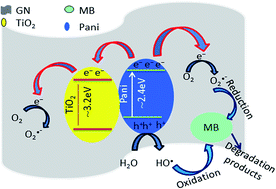Facile route to a conducting ternary polyaniline@TiO2/GN nanocomposite for environmentally benign applications: photocatalytic degradation of pollutants and biological activity
Abstract
A polyaniline@TiO2/graphene (Pani@TiO2/GN) nanocomposite was prepared by the in situ oxidative polymerization of aniline in the presence of TiO2 and GN nanoparticles. The resulting Pani@TiO2/GN nanocomposite was characterized by UV-visible diffuse absorbance/reflectance spectroscopy (DRS), photoluminescence spectroscopy (PL), transmission electron microscopy, scanning electron microscopy, X-ray diffraction (XRD) and X-ray photoelectron spectroscopy (XPS). The observance of peaks of Pani, TiO2 and GN in XRD and XPS as well as the observance of TiO2 nanoparticles well distributed inside the network of the Pani and GN nanosheets from morphological characterizations suggests the successful formation of Pani@TiO2/GN nanocomposites. DRS and PL analysis showed that Pani@TiO2/GN had higher visible light absorption and a lower recombination rate than Pani@TiO2. The visible light photocatalytic activity of the Pani@TiO2/GN nanocomposite was tested for methylene blue (MB) degradation. The results revealed high photocatalytic activity, which is partly due to the sensitizing effect of Pani and the low recombination rate due to the GN electron scavenging property. The rate of MB degradation on the Pani@TiO2/GN nanocomposite was strongly dependent on the solution pH, reaction time, catalyst dose, and the initial MB concentration. The high regeneration degradation efficiency of the Pani@TiO2/GN nanocomposite showed high stability and the effectiveness of the synthesized photocatalyst. In a continuation of environmental remediation studies, Pani@TiO2/GN revealed high antibacterial activity towards Escherichia coli and Enterobacter ludwigii, highlighting its potential as a photocatalyst with antibacterial properties for different industrial and medical purposes.


 Please wait while we load your content...
Please wait while we load your content...